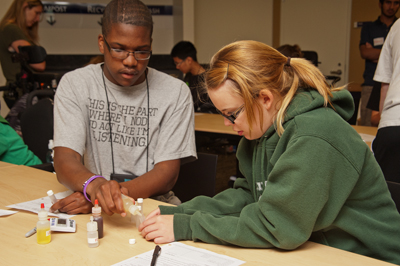Killing Killer Organisms?

On the third day of Summer Study, we were introduced to people at Seattle Biomedical Research Institute (SBRI), and what it means to work there. They study all kinds of different diseases.
SBRI finds ways to prevent viruses from speeding up and killing more people around the world. The disease we focused on in the class was tuberculosis (TB). TB travels by air, making it more contagious. It is most common to get in the lungs, but you can still get it anywhere.
After hearing all about their jobs, we were put into groups and given chemicals to see if we could destroy a virus. Each group had one jar of FDA, LB, and MEG. We then mixed the MEG with the LB, shook them for five seconds, and let them sit for three minutes. Then we chose three solutions from a table that had thirty or more different types of solutions from bleach to Bactine. We mixed those solutions with our MEG and LB, let them sit for three minutes, and then put the black light on to see if any of them worked. We all leaned in and squinted our eyes to see changes in the solutions. We were looking for the dimmer coloring. That meant the chemical would have killed the FDA. It was hard to tell what was light and what was dim. We loved all the bright colors the solutions created.
We learned about diseases that we hadn't heard of and how new diseases are evolving past our vaccines. This field of work needs more people to test and develop vaccines to help benefit the whole world.